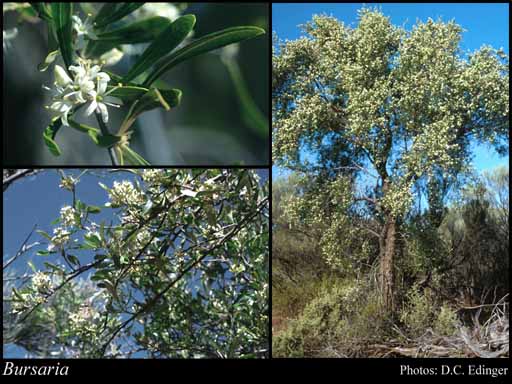- Reference
- Icon. 30 (1797)
- Name Status
- Current

Scientific Description
Common name. Bursarias. Family Pittosporaceae.
Habit and leaf form. Small trees, or shrubs; evergreen. Plants spiny (branch and branchlets). To 1–12 m high. Mesophytic. Not heterophyllous. Leaves small; alternate (or clustered); spiral; petiolate; simple. Leaf blades dorsiventral; entire; linear, or ovate, or obovate, or elliptic (or cuneate). Mature leaf blades adaxially glabrous; abaxially glabrous, or pubescent. Leaf blade margins entire (or emarginate), or serrate (rarely).
Reproductive type, pollination. Fertile flowers hermaphrodite. Unisexual flowers absent. Plants hermaphrodite.
Inflorescence and flower features. Flowers solitary, or aggregated in ‘inflorescences’. Inflorescence few-flowered, or many-flowered. Flowers in racemes, or in panicles. Inflorescences terminal, or axillary. Flowers pedicellate; bracteate; small; regular; 5 merous; tetracyclic. Perianth with distinct calyx and corolla; 10; 2 -whorled; isomerous. Calyx present; 5; 1 -whorled; polysepalous; hairy, or glabrous; exceeded by the corolla; persistent, or not persistent. Corolla present; 5; 1 -whorled; polypetalous (spreading from the base); imbricate; regular; plain; white, or cream. Petals oblong. Androecium present. Androecial members definite in number. Androecium 5. Androecial members free of the perianth; free of one another. Stamens 5; all more or less similar in shape; isomerous with the perianth; oppositisepalous; all alternating with the corolla members. Anthers all alike; dehiscing via longitudinal slits; tetrasporangiate. Fertile gynoecium present. Gynoecium 2 carpelled. The pistil 2 celled. Gynoecium syncarpous; eu-syncarpous; superior. Ovary plurilocular; 2 locular; shortly stipitate. Ovary summit glabrous, or hairy, the hairs not confined to radiating bands. Gynoecium stylate. Styles 1. Stigmas 1. Placentation parietal. Ovules 30–50 per locule (i.e. ‘many’).
Fruit and seed features. Fruit 5–15 mm long; shortly stipitate; non-fleshy; dehiscent; a capsule (purse-like). Capsules loculicidal. Dispersal unit the seed. Fruit 10–50 seeded (few to many). Seeds compressed (flat; reniform or orbicular); wingless.
Geography, cytology, number of species. World distribution: Australia. Native of Australia. Endemic to Australia. Australian states and territories: Western Australia, South Australia, Queensland, New South Wales, Victoria, Australian Capital Territory, and Tasmania. South-West Botanical Province. A genus of 6 species; 1 species in Western Australia.
Additional comments. Etymology: from Latin bursa, a pouch; alluding to the fruit.
Etymology. From the Latin for "bag or satchel"; refers to the fruit.